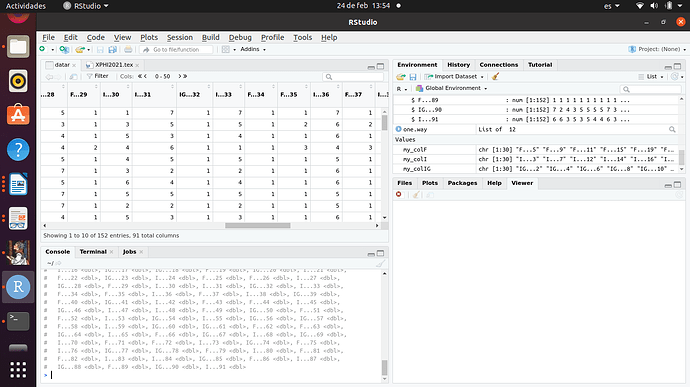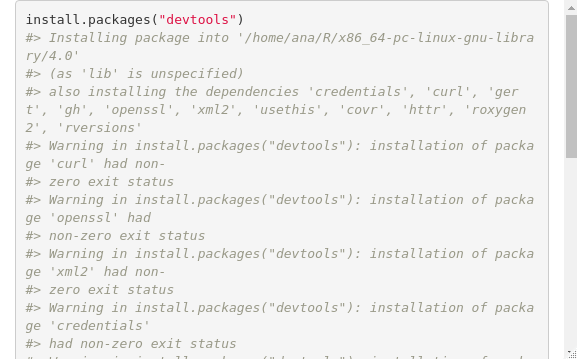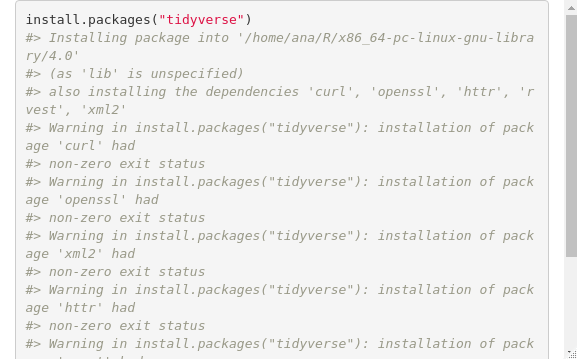I have uploaded my data, and I need to run a one-way anova that compares I to IG and to F. I could run it with just one column, but I need to analyze all the data. Bellow is my dataframe:
data.frame(datar)
Interview.number..ongoing. IG...2 I...3 IG...4 F...5 IG...6 I...7 IG...8 F...9 IG...10
1 134 5 7 5 1 4 2 1 1 7
2 146 4 7 5 1 2 3 2 1 2
3 156 6 5 7 1 3 2 1 1 5
4 159 5 5 4 2 2 1 2 1 5
5 160 6 4 6 1 5 3 4 1 5
6 165 5 3 6 1 5 2 4 1 6
7 183 7 5 6 1 5 3 4 1 5
8 184 7 5 7 1 5 2 3 1 6
9 185 7 2 7 1 6 2 6 1 7
10 187 5 6 6 1 3 3 1 3 5
F...11 I...12 IG...13 I...14 F...15 I...16 IG...17 IG...18 F...19 IG...20 I...21 F...22
1 1 2 6 7 1 5 1 4 1 1 6 1
2 4 3 3 6 1 4 4 3 1 5 3 1
3 1 2 5 3 1 3 2 3 1 2 3 1
4 1 1 1 5 1 6 2 4 1 2 1 1
5 1 3 5 4 1 4 5 5 1 1 4 1
6 1 2 5 3 1 2 4 3 1 5 2 1
7 1 3 6 4 1 3 4 5 1 4 4 1
8 1 2 6 5 1 5 4 4 1 1 5 1
9 1 2 7 2 1 3 7 7 1 7 3 1
10 2 3 4 5 1 5 2 2 1 3 5 1
IG...23 I...24 F...25 F...26 I...27 IG...28 F...29 I...30 I...31 IG...32 I...33 F...34
1 6 6 1 1 6 5 1 1 7 1 7 1
2 5 7 1 1 7 3 1 3 5 1 5 1
3 5 4 1 1 4 4 1 5 3 1 4 1
4 2 3 1 1 3 4 2 4 6 1 1 1
5 6 5 1 1 5 5 1 4 5 1 5 1
6 5 5 1 1 3 7 1 3 2 1 2 1
7 6 3 1 1 3 5 1 6 4 1 4 1
8 5 5 1 1 5 7 1 5 5 1 5 1
9 1 4 1 1 4 7 1 2 2 1 2 1
10 3 5 1 2 4 4 1 5 3 1 3 1
F...35 I...36 F...37 I...38 IG...39 F...40 IG...41 I...42 F...43 F...44 I...45 IG...46
1 1 7 1 5 5 1 5 5 1 1 4 1
2 2 6 2 6 1 1 2 4 1 1 5 1
3 1 6 1 3 3 1 3 3 1 1 2 1
4 3 4 3 3 3 1 5 3 1 1 3 3
5 1 5 1 3 5 1 5 3 1 1 3 1
6 1 6 1 3 5 1 5 3 1 1 5 1
7 1 6 1 3 4 1 3 3 1 1 2 2
8 1 5 1 5 7 1 7 5 1 1 3 2
9 1 5 1 2 7 1 7 2 1 1 1 1
10 1 6 1 2 4 1 3 2 1 1 3 2
I...47 I...48 F...49 IG...50 F...51 F...52 I...53 IG...54 I...55 IG...56 IG...57 F...58
1 4 1 1 4 1 1 4 5 1 6 5 1
2 5 5 1 3 1 1 6 3 6 2 6 1
3 2 2 1 3 1 1 2 5 2 4 5 1
4 4 3 1 3 1 1 1 3 3 4 5 1
5 3 1 1 5 1 1 4 6 3 5 5 1
6 5 5 1 6 1 1 6 6 5 6 6 1
7 2 3 1 4 1 1 2 4 3 3 4 1
8 3 1 1 7 1 1 4 7 1 6 7 1
9 1 1 1 7 1 1 2 7 3 6 7 1
10 3 1 1 3 1 1 3 4 3 4 5 1
I...59 IG...60 IG...61 F...62 F...63 IG...64 I...65 F...66 IG...67 I...68 IG...69 I...70
1 3 4 5 1 1 5 1 1 7 6 4 6
2 5 1 3 2 1 3 4 2 5 7 1 6
3 2 2 3 1 1 3 2 1 6 4 1 4
4 2 2 3 1 1 5 4 2 4 5 1 6
5 4 5 5 1 1 5 3 1 6 4 4 5
6 5 6 3 1 1 5 2 1 7 5 4 5
7 4 5 4 1 1 4 3 1 7 5 3 5
8 5 5 4 1 1 5 3 1 7 1 1 6
9 5 7 4 1 1 7 2 1 7 6 1 5
10 4 3 2 1 1 2 2 1 6 4 1 5
F...71 F...72 I...73 IG...74 F...75 I...76 IG...77 IG...78 F...79 I...80 F...81 F...82
1 1 1 4 1 1 5 6 6 1 1 1 1
2 1 5 5 1 1 5 2 1 1 1 1 1
3 1 1 3 2 1 4 6 4 1 1 1 1
4 1 1 3 1 1 5 4 3 1 1 1 1
5 1 1 3 5 1 4 5 5 1 2 1 1
6 1 1 3 5 1 5 7 6 1 5 1 1
7 1 1 4 1 1 4 5 5 1 3 1 1
8 1 1 4 1 1 3 7 2 1 1 1 1
9 1 1 1 1 1 3 7 7 1 3 1 1
10 1 1 4 1 1 4 5 3 1 1 1 1
I...83 I...84 IG...85 F...86 I...87 IG...88 F...89 IG...90 I...91
1 5 3 5 1 7 7 1 7 6
2 5 5 2 1 5 1 1 2 6
3 4 5 4 1 5 5 1 4 3
4 4 3 6 1 5 6 1 3 5
5 5 3 5 1 5 5 1 5 3
6 5 3 6 1 7 5 1 5 5
7 4 4 5 1 6 5 1 5 4
8 5 4 7 1 7 4 1 5 4
9 4 3 7 1 3 7 1 7 6
10 5 3 4 1 4 3 1 3 3
[ reached 'max' / getOption("max.print") -- omitted 142 rows ]


